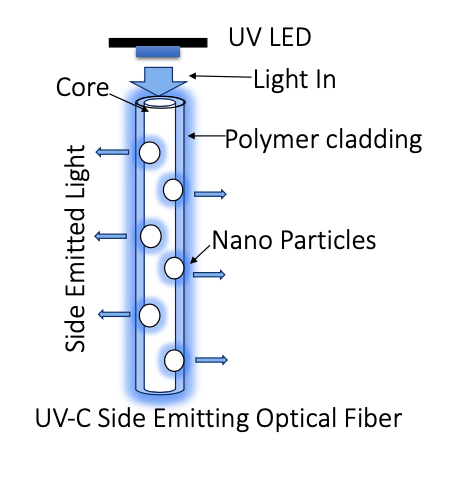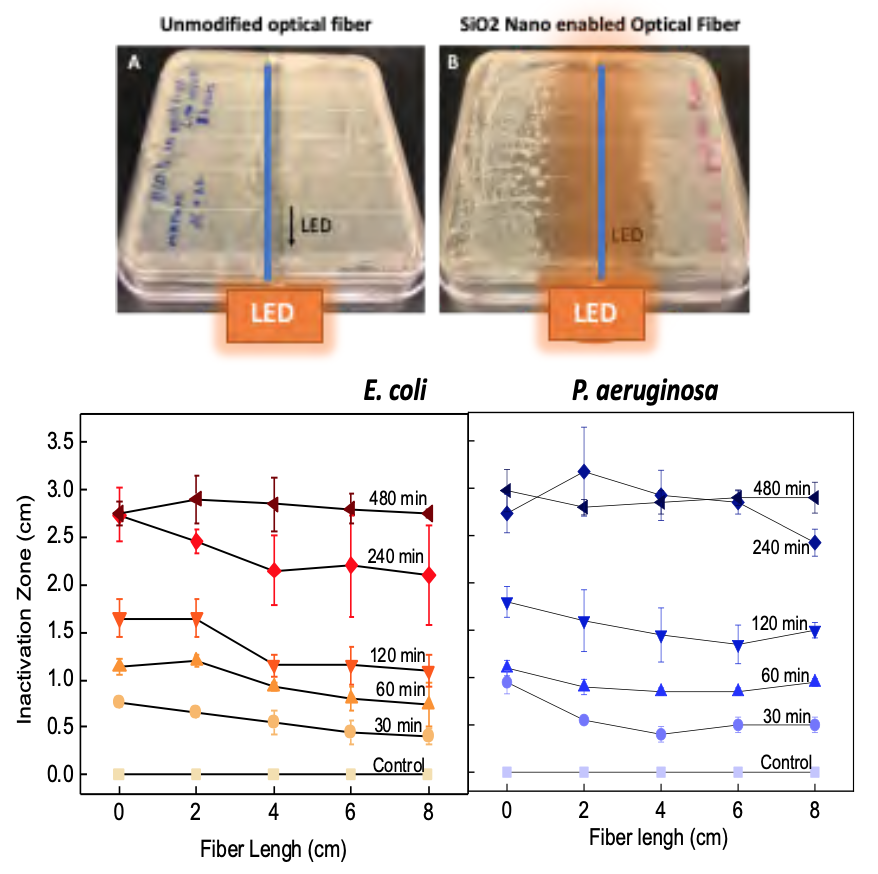Researchers Develop UV-C Side-Emitting Optical Fibers for Planktonic and Biofilm Bacteria Control
Outcome/Accomplishment
National Science Foundation (NSF)-supported researchers with the Nanotechnology Enabled Water Treatment (NEWT) Engineering Research Center (ERC), headquartered at Rice University, have successfully designed transparent, particle-modified polymer coatings that emit light to inhibit the growth of E. coli bacteria in water. The side-emitting-optical fibers (SEOFs) effectively create a flexible, germicidal "glowstick" that is stable in water and can be inserted into narrow-diameter channels such as piping or tubing. The work is a collaborative effort with start-up company H2O Insights, launched by NEWT faculty and students. H2O Insights recently received NASA Small Business Technology Transfer (STTR)–Phase I funding and joined the NEWT Industry Practitioner Advisory Board (IPAB).
Impact/Benefits
Commercially available light-emitting diodes (LEDs) have been known to be a disinfectant, but they afford only limited light emissions and can be difficult to deploy efficiently because lights must be close to microbes in order to kill them. Also, current light purification systems use bulky lamps that are inefficient or unavailable in developing countries, where water sanitation needs are greater. Flexible glass optical fibers offer a solution and are widely used in the telecommunication, medical, and other industries. However, when biofilm grows on wet surfaces, bacterial growth on the film may harbor pathogens or cause operational problems for water-based systems. NEWT's patent-pending nanotechnology-enabled optical fibers emit germicidal ultraviolet light along their entire length like a glowstick to eliminate biofilm growth and better protect both systems and organisms. SEOFs can also be woven into a fabric capable of disinfecting water at a closer range. The innovation is supported by NASA for potential use on the International Space Station (ISS).
Explanation/Background
LEDs that emit germicidal 265 nanometer (nm) light, known as UV-C, have limited emission at less than one square centimeter. But by attaching side emitting optical fibers (SEOFs) to the same LED, the UV-C light emission area increases by more than 500x.
SEOFs are produced by coating 0.3-1 mm (millimeter diameter) optical fibers with a thin layer of aminated silicon dioxide (SiO2) particles overlaid with a layer of UV light transparent polymer to enhance radial light scattering. The resulting optical fiber extends the emission of germicidal UV-C light in a more effective and flexible material. SEOFs can be inserted into tubing or other geometries where biofilm mitigation is otherwise difficult to achieve.
The research on and commercial production of SEOFs is led by NEWT doctoral candidate Mariana Lanzarini-Lopes—an Achievement Rewards for College Scientists (ARCS) Scholar at Arizona State University (ASU). The team's findings were published in the Journal of the Optical Society of America B and in Environmental Science and Technology. A video presentation describing the project is also available on YouTube.
Location
Houston, Texaswebsite
Start Year
Energy and Sustainability
Energy, Sustainability, and Infrastructure
Lead Institution
Core Partners
Fact Sheet
Outcome/Accomplishment
National Science Foundation (NSF)-supported researchers with the Nanotechnology Enabled Water Treatment (NEWT) Engineering Research Center (ERC), headquartered at Rice University, have successfully designed transparent, particle-modified polymer coatings that emit light to inhibit the growth of E. coli bacteria in water. The side-emitting-optical fibers (SEOFs) effectively create a flexible, germicidal "glowstick" that is stable in water and can be inserted into narrow-diameter channels such as piping or tubing. The work is a collaborative effort with start-up company H2O Insights, launched by NEWT faculty and students. H2O Insights recently received NASA Small Business Technology Transfer (STTR)–Phase I funding and joined the NEWT Industry Practitioner Advisory Board (IPAB).
Location
Houston, Texaswebsite
Start Year
Energy and Sustainability
Energy, Sustainability, and Infrastructure
Lead Institution
Core Partners
Fact Sheet
Impact/benefits
Commercially available light-emitting diodes (LEDs) have been known to be a disinfectant, but they afford only limited light emissions and can be difficult to deploy efficiently because lights must be close to microbes in order to kill them. Also, current light purification systems use bulky lamps that are inefficient or unavailable in developing countries, where water sanitation needs are greater. Flexible glass optical fibers offer a solution and are widely used in the telecommunication, medical, and other industries. However, when biofilm grows on wet surfaces, bacterial growth on the film may harbor pathogens or cause operational problems for water-based systems. NEWT's patent-pending nanotechnology-enabled optical fibers emit germicidal ultraviolet light along their entire length like a glowstick to eliminate biofilm growth and better protect both systems and organisms. SEOFs can also be woven into a fabric capable of disinfecting water at a closer range. The innovation is supported by NASA for potential use on the International Space Station (ISS).
Explanation/Background
LEDs that emit germicidal 265 nanometer (nm) light, known as UV-C, have limited emission at less than one square centimeter. But by attaching side emitting optical fibers (SEOFs) to the same LED, the UV-C light emission area increases by more than 500x.
SEOFs are produced by coating 0.3-1 mm (millimeter diameter) optical fibers with a thin layer of aminated silicon dioxide (SiO2) particles overlaid with a layer of UV light transparent polymer to enhance radial light scattering. The resulting optical fiber extends the emission of germicidal UV-C light in a more effective and flexible material. SEOFs can be inserted into tubing or other geometries where biofilm mitigation is otherwise difficult to achieve.
The research on and commercial production of SEOFs is led by NEWT doctoral candidate Mariana Lanzarini-Lopes—an Achievement Rewards for College Scientists (ARCS) Scholar at Arizona State University (ASU). The team's findings were published in the Journal of the Optical Society of America B and in Environmental Science and Technology. A video presentation describing the project is also available on YouTube.


